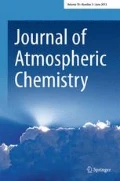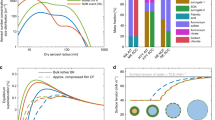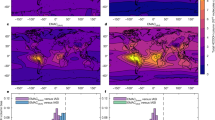Abstract
Current climate models seem to underestimate the flux of solar energy absorbed by the global troposphere. All of these models are constrained with the assumption that cloud droplets consist of pure water. Here we demonstrate in a simple laboratory experiment that aromatic hydroxy-acids which are found in continental fine aerosol can react with hydroxyl radicals under typical conditions prevalent in cloud water influenced by biomass burning. The reactions yield colored organic species which do absorb solar radiation. We also suggest that the products of such reactions may be humic-like substances whose presence in continental aerosol has been confirmed but their source mechanisms are still much sought after. We also attempt to give a first order estimate of the enhancement of water absorption at a visible wavelength under atmospheric conditions.
Similar content being viewed by others
References
Andreae, M. O. and Crutzen, P. J., 1997: Atmospheric aerosols: Biogeochemical sources and role in atmospheric chemistry, Science 276, 1052–1058.
Rogge, W. F., Mazurek, M. A., Hildemann, L. M., Cass, G. R., and Simoneit, B. R. T., 1993: Quantification of urban organic aerosol at a molecular level: Identification, abundance and seasonal variation, Atmos. Environ. 27A, 1309–1330.
Mayol-Bracero, O. L., Guyon, P., Graham, B., Roberts, G., Andreae, M. O., Decesari, S., Facchini, M. C., Fuzzi, S., and Artaxo, P., 2001: Water soluble organic compounds in biomass burning aerosol over Amazonia: Apportionment of the chemical composition and importance of the polyacidic fraction, J. Geophys. Res., in press.
Graham, B., Mayol-Bracero, O. M., Guyon, P., Roberts, G., Decesari, S., Facchini, M. C., Artaxo, P., Maenhaut, W., Köll, P., and Andreae, M. O., 2001:Water soluble organic compounds in biomass burning aerosol over Amazonia: 1. Characterization by NMR and GC-MS, J. Geophys. Res., in press.
Penner, J. E., 1994: Carbonaceous aerosols influencing atmospheric radiation: Black and organic carbon, in R. J. Charlson and J. Heintzenberg (eds), Aerosol Forcing of Climate, John Wiley & Sons, Berlin, pp. 91–108.
Duce, R. A., 1994: Sources, distributions, and fluxes of mineral aerosols and their relationship to climate, in R. J. Charlson and J. Heintzenberg (eds), Aerosol Forcing of Climate, John Wiley & Sons, Berlin, pp. 43–72.
Gelencsér, A., Mészáros, T., Blazsó, M., Kiss, G., Krivácsy, Z., Molnár, A., and Mészáros, E., 2000: Structural characterisation of organic matter in fine tropospheric aerosol by pyrolysis-gas chromatography-mass spectrometry, J. Atmos. Chem. 37, 173–183.
Zappoli, S., Andracchio, A., Fuzzi, S., Facchini, M. C., Gelencsér, A., Kiss, G., Krivácsy, Z., Molnár, A., Mészáros, E., Hansson, H. C., and Rosman, K., 1999: Inorganic, organic and macromolecular components of fine aerosol in different areas of Europe in relation to their water solubility, Atmos. Environ. 33, 2733–2743.
Gelencsér, A. Hoffer, A., Krivácsy, Z., Molnár, A., and Mészáros, E., 2001: On the possible origin of humic matter in fine continental aerosol, J. Geophys. Res., in press
Talbot, R. W., Andreae, M. O., Andreae, T. W., and Hamss, R. C., 1988: Regional aerosol chemistry of the Amazon basin during the dry season, J. Geophys. Res. 93, 1499–1508.
Richards, G. N., Shafizadeh, F., and Stevenson, T. T., 1983: Influence of sodium chloride on volatile products formed by pyrolysis of cellulose: Hydroxybenzenes and 1-hydroxy-2-propanone as major products, Carbohydr. Res. 117, 322–327.
Facchini, M. C., Fuzzi, S., Zappoli, S., Andracchio, A., Gelencsér, A., Kiss, G., Krivácsy, Z., Mészáros, E., Hansson, H. C., Alsberg, T., and Zebühr, Y., 1999: Partitioning of the organic aerosol component between fog droplets and interstitial air, J. Geophys. Res. 104, 26,821–26,832.
Lelieveld, J. and Crutzen, P. J., 1991: The role of clouds in tropospheric photochemistry, J. Atmos. Chem. 12, 229–267.
Herrmann, H., Ervens, B., Jacobi, H. W., Wolke, R., Nowacki, P., and Zellner, R., 2000: CAPRAM2.3: A chemical aqueous phase radical mechanism for tropospheric chemistry, J. Atmos. Chem. 36, 231–284.
Gunz, D. W. and Hoffmann, M. R., 1990: Atmospheric chemistry of peroxides: A review, Atmos. Environ. 24A, 1601–1633.
Dwibedy, P., Dey, G. R., Naik, D. B., Kishore, K., and Moorthy, P. N., 1999: Pulse radiolysis studies on redox reactions of gallic acid: One electron oxidation of gallic acid by gallic acid OH adduct, Phys. Chem. Chem. Phys. 1, 1915–1918.
Senesi, N. and Steelink, C., 1989: Application of ESR spectroscopy to the study of humic substances, in M. B. H. Hayes, P. MacCarthy, R. L. Malcolm, R. S. Swift (eds) Humic Substances II. In Search of Structure, Wiley, New York, pp. 373–408.
Wang, T. S. C., Wang, M. C., Ferng, Y. L., and Huang, P. M., 1983: Catalytic synthesis of humic substances by natural clays, silts and soils, Soil Sci. 135, 350–360.
Tombácz, E., Szekeres, M., Baranyi, L., and Michéli, E., 1998: Surface modification of clay minerals by organic polyions, Colloids Surf. 141, 379–384.
Wiscombe, W. J., 1995: An absorbing mystery, Nature 376, 466–467.
Li, Z., Barker, H. W., and Moreau, L., 1995: The variable effect of clouds on atmospheric absorption of solar radiation, Nature 376, 486–490.
Ramanathan, V., Valero, F. P. J., and Cess, R. D., 1996: Excess solar absorption in cloudy atmospheres, GEWEX News 6, 6–7.
Twohy, C. H., Clarke, A. D., Warren, S. G., Radke, L. F., and Charlson, R. J., 1989: Light-absorbing material extracted from cloud droplets and its effect on cloud albedo, J. Geophys. Res. 94, 8,623–8,631.
Horvath, H., 1995: Atmospheric light absorption – a review, Atmos. Environ. 27A, 293–317.
Author information
Authors and Affiliations
Rights and permissions
About this article
Cite this article
Gelencsér, A., Hoffer, A., Kiss, G. et al. In-situ Formation of Light-Absorbing Organic Matter in Cloud Water. Journal of Atmospheric Chemistry 45, 25–33 (2003). https://doi.org/10.1023/A:1024060428172
Issue Date:
DOI: https://doi.org/10.1023/A:1024060428172




